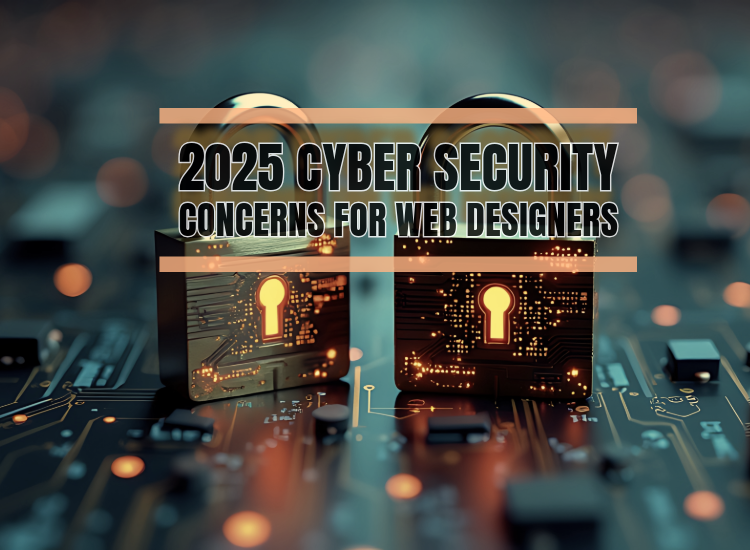Cybersecurity Threats Web Designers Need to Watch in 2025
By Creative Designs By CCW · April 5, 2025 ·Introduction:
In 2025, web design isn’t just about clean layouts and pixel-perfect typography—it’s about building digital experiences that are not only beautiful but secure. With cyber threats evolving at lightning speed, web designers play a critical role in defending websites from attacks. From insecure front-end code to malicious plugins, the modern web designer needs to have a security-first mindset. Here are the top cybersecurity threats web designers need to watch out for in 2025—and how to build smarter, safer websites.
Malicious or Vulnerable Third-Party Plugins
WordPress, Webflow, Shopify, and other CMS platforms offer thousands of plugins and templates—but many of them are outdated or contain security flaws. Some even come with embedded malware.
Threat: Exploitable vulnerabilities or hidden malicious scripts in plugins/themes.
What to Do:
- Vet all third-party plugins and only use those with active maintenance and strong reviews
- Remove unused plugins and themes.
- Keep everything updated regularly.
Cross-Site Scripting (XSS)
XSS is one of the most common web vulnerabilities. It occurs when untrusted user input is executed as code in the browser—often due to improper validation or sanitation.
Threat: Hackers inject scripts to steal user data, hijack sessions, or redirect traffic.
What to Do:
- Always sanitize and escape user-generated content.
- Use modern frameworks (like React or Vue) that handle XSS more safely by default.
- Enable Content Security Policy (CSP) headers to limit what scripts can run.
Form Injection and Data Handling Risks
Poorly designed forms can be an easy gateway for SQL injection, credential theft, or data leakage—especially if the data is sent without encryption or stored insecurely.
Threat: Sensitive user data exposed through weak form implementation.
What to Do:
- Use HTTPS—always.
- Validate input on both client and server sides..
- Avoid storing unnecessary user data, and use proper encryption for anything sensitive.
Insecure APIs and Headless Integrations
In the era of headless CMS and JAMstack architecture, web designers increasingly rely on APIs to pull in content, forms, or dynamic elements. But unsecured APIs can be a major risk.
Threat: API endpoints exposed to abuse, data scraping, or injection attacks.
What to Do:
- Ensure APIs are authenticated and rate-limited.
- Use HTTPS to encrypt data in transit.
- Validate all inputs and outputs from API responses.
SEO Spam and Content Injection
Attackers often exploit websites (especially WordPress sites) to inject spammy links or content. These can tank your search rankings and redirect users to malicious sites.
Threat: Website defacement and SEO poisoning.
What to Do:
- Regularly scan your site for unauthorized changes.
- Monitor server logs for suspicious activity.
- Set up alerts for unusual content changes or traffic spikes.
Credential Stuffing on Admin Panels
If your design or CMS tools have default login URLs (like /wp-admin or /admin), they’re a prime target for brute force and credential stuffing attacks.
Threat: Hackers gain admin access using leaked or weak passwords.
What to Do:
- Rename default admin URLs when possible.
- Enforce strong password policies and use 2FA (two-factor authentication).
- Limit login attempts and enable IP blacklisting after failed logins.
Overreliance on AI Web Builders
AI-generated sites and code (via tools like ChatGPT, Wix AI, or Framer AI) are fast and convenient—but they may also introduce generic or unsecure code patterns.
Threat: Automated designs may skip critical security best practices.
What to Do:
- Review all auto-generated code manually.
- Implement security best practices before deployment.
- Stay updated with web security guidelines from organizations like OWASP.
Final Thoughts: Secure Design is Smart Design
In 2025, web design is about more than aesthetics. Your design choices can open—or close—the door to attackers. As a designer, you're the first line of defense in shaping how users interact with the web securely.
Build with empathy, build with creativity—but most importantly, build with security in mind.
Let's stay ahead of the curve and lock things down—before the hackers get in.








